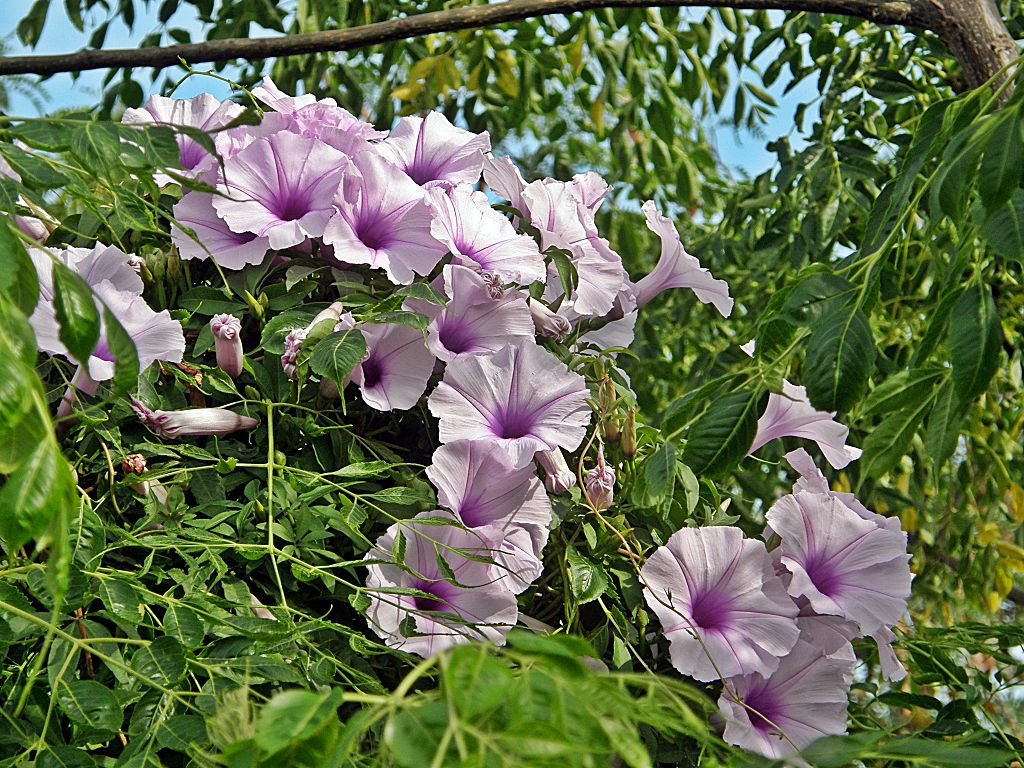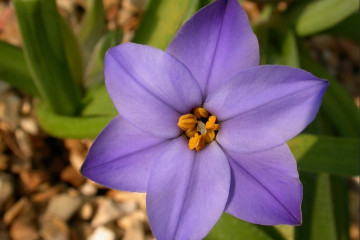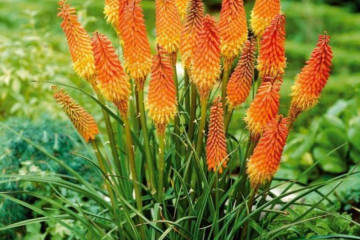Morning glory - planting and care in the open field
Content:
- Origin and appearance
- Morning glory: planting and care in the open field
- Popular types of morning glory for growing in the garden
- Growing conditions
- Growing from seeds
- Seedling care
- Seedling care
- When and how to plant morning glory in open ground
- Watering mode
- How to feed morning glory for abundant flowering
- Features of care during the flowering period
- Features of care during the rest period
- Collection and storage of seeds
- Propagation of morning glory by cuttings
- Preparing for winter
- Potential pests and diseases
Morning glory (popular name - loach) is a very popular plant, actively used in the process of forming landscape design. Another name for the plant is farbitis. The flower culture is considered unpretentious to care for, has a lot of species and varieties that differ in colors, the shape of buds and leaves. To grow a full-fledged plant, you need to remember certain rules that relate to care.
Ipomoea annual is a tall climbing plant that is easy to grow in an open field or flowerpot. The aerial part grows within 2-4 weeks, braiding supports of a different nature. The liana blooms magnificently, releasing relatively large buds.
Origin and appearance
Ipomoea is a representative of the Vyunkov family. The native land of the plant is tropical and equatorial forests. The bindweed has two varieties - bush and liana. In the climate of Russia (on the street) it grows like an annual. The indoor version of the flower is a miniature copy of a tropical giant.
Description of the appearance of morning glory:
- liana can braid any support, as it has a flexible thin stem that can reach a length of 5 m;
- buds in the form of a gramophone head of different diameters and colors, it all depends on the variety;
- the leaves are shaped like droplets of bright green or emerald color with a weakly pronounced structure of veins.
Morning glory will help create an original landscape design. This versatility is due not only to the way the stem grows, but also to its appearance: flowers that are simple in shape and many green leaves are easily combined with any type of plant within the same flower bed.
Bushy varieties and some liana-like varieties are often planted in a pot. This technique allows you to create elements of living decor for a terrace, balcony, veranda, loggia. The plant is often planted near gazebos, fences and other tall buildings.
Rapid growth and density of shoots will allow you to quickly form a decent composition. Nice culture goes well with:
- hops;
- capsis;
- wild grapes;
- ivy.
Experienced flower growers make curly arches, supports, which are later braided by the stem. The result is living art objects. In such compositions, it is better to combine a flower with low-growing plants or ornamental shrubs.
When morning glory blossoms, the garden begins to play with new colors. Such a riot of colors is possible thanks to the coloring of the buds. Flowering begins at the end of June and ends at the end of September. Ipomoea flowers can be of different colors and produce different aromas. Usually, the buds are not of a monochromatic color, but a rolling one: from more saturated to light.
Morning glory: planting and care in the open field
Ipomoea in the open field can surprise with its lush flowering and rapid growth.You can also plant a flower in a planter to decorate an outdoor terrace or veranda.
Features of growing perennial morning glory
Perennial species are not popular in Russia, as the climate does not meet the needs of the plant. But in greenhouses, greenhouses and verandas, perennials feel very comfortable, the main thing is to provide decent care.
Features of planting and caring for perennial morning glory:
- it is necessary to plant sprouts in disinfected soil;
- you need to choose spacious flowerpots, on the bottom of which a drainage layer is laid;
- it is advisable to install pots with farbitis on the south side near the window;
- requires regular watering.
These are the basic conditions for the normal growth of perennial varieties.
Popular types of morning glory for growing in the garden
Morning glory is a flower that is very popular among flower growers. There are many varieties that have different color of buds, stem length, color and size of leaves, principles of use in the garden or flower bed.
Morning glory Batat
The sweet potato variety in many countries is a food product where the roots and stem are edible. Description of Ipomoea Batat:
- herbaceous plant, reaching 30 cm in height;
- the volume of the bush can be up to 2 m wide;
- leaves are large purple;
- the buds are sky blue.
Ipomoea purple
Ipomoea purple can reach 8 m in height. The buds are 8 cm in diameter. Common gramophone colors: ultraviolet, red, purple. Particularly common purple varieties:
- sky blue;
- Giselle;
- Raspberry whim;
- The firmament.
There are other varieties, but they are less popular in floriculture.
Morning glory Kvamoklit
Ipomoea Kvamoklit has a second name - cypress liana. An annual plant with a liana-shaped trunk up to 5 m. Kvamoklit comes from Mexico. Popular varieties:
- morning glory Kvamoklit red;
- Slaughter;
- Quamoklite is pinnate;
- fiery red.
Interesting in these srot is the principle of flowering.
Morning glory trip
Morning glory Trip is unique in its structure and color of buds. The plant is intended for garden decoration and is distinguished by its growth rate. The petals are purple in color with a three-stage transition to a more delicate shade.
Ipomoea Paradise Stars
Ipomoea purple Paradise stars has a liana-shaped trunk 3 m high. The "star" appearance of the flower is distinguished by lush flowering, huge buds, mostly light blue with a transition to a darker one. The most popular Scarlett variety.
Growing conditions
Morning glory, planting and caring for which is not difficult, still requires attention to itself. Initially, you need to lay the planting material at the right time and properly care for the sprouts.
Growing from seeds
In order for the farbitis to get ready to bloom at the end of May, it is necessary to plant the seeds on time. After their germination, special attention should be paid to the development of seedlings.
Ipomoea seeds should be planted in early March. To do this, prepare small cups of peat. The base should be slightly damp. Before planting the seeds, you can soak them in the solution to promote growth.
Seedling care
For the rapid growth of seedlings, you need to organize suitable conditions:
- put sprouts under the lamp for additional heating and lighting;
- moisten the soil with a spray gun when the soil dries out;
- if necessary, you need to thin out the seedlings by removing a few units.
With elementary care, the seedlings will quickly get stronger and turn into high-quality seedlings.
Seedling care
Seedlings will definitely not bloom in peat pots, but they will begin to weave almost immediately. One week after germination, the supports must be installed immediately. If the seedlings are intertwined with each other, then it will not work to untangle them before planting.
When and how to plant morning glory in open ground
You can grow a full-fledged plant if you plant the shoots in open ground in time. The ideal time to transfer is early June. It is not worth removing the earthen lump from the root system.
You need to choose a place where the acidity of the soil will be medium. Pre-apply complex fertilizers. Farbitis should be planted in an open area so that direct sunlight falls on the flower from all sides.
Watering mode
At first, the flower will consume a lot of water, but over time, the need for irrigation will decrease. The main thing is not to overdo it with watering, otherwise the root system will rot. Watering should be done when the ground under the bush dries up.
How to feed morning glory for abundant flowering
In order for flowering to be plentiful and timely, fertilizers need to be applied on time. It is advisable to use a mixture of common humus and deciduous soil. You need to apply about half a bucket of dry fertilizer under the bush. If you feed the plant with a surplus, then the root system will only develop strongly.
Features of care during the flowering period
During the flowering period, farbitis must be properly looked after:
- make sure that the soil under the bush does not dry out;
- constantly loosen the soil to avoid stagnant moisture;
- feed once every 3 weeks.
Additionally, you need to remove dry, damaged processes and already faded buds.
Features of care during the rest period
During the dormant period, you need to reduce watering. You shouldn't apply fertilizer either to slow down growth. It is necessary to remove the aerial part of the flower. It is important that in the cool season there is no overgrowth of the stem and branches.
Collection and storage of seeds
Abundant flowering guarantees a good seed yield. You need to collect planting material at the beginning of September. Otherwise, the boxes will open on their own, and self-seeding will occur.
The material should be placed in glass jars, which in turn should be placed in a dark, slightly cool place until next year.
Propagation of morning glory by cuttings
Reproduction can be carried out not only by sowing, but also by cuttings. How to prepare and rooting a cutting:
- Cut a twig from a bush.
- Cut off 20 cm from the workpiece so that two nodes remain on the future cutting.
- The cut is made at an angle of 45 °.
- Place the cutting in water. Roots will appear in five days.
- Place the workpieces in a peat, pre-moistened substrate.
After a week, the cutting will take root and become suitable for planting in a flower bed. This option is a minor way of growing a flower.
Preparing for winter
The type of culture is not frost-resistant at all. Therefore, only annual varieties are planted in Russia. But even such specimens need to be prepared for winter: cut off the ground part and some of the stems as much as possible.
Potential pests and diseases
Poor care is not the only cause of disease or pests. Growing in the open field itself is a challenge. What diseases and pests can harm farbitis:
- Aphids often grow on the leaves. You can determine the presence of such an insect by yellow spots or sticky dew. Insecticides will help get rid of the pest.
- The spider mite leaves behind dark spots and a thin cobweb along the stems.You can remove the tick by constantly bathing the aboveground part under the pressure of running water.
- Fungal diseases are widespread - gray rot, rust, powdery mildew. It is necessary to remove the infected areas and treat the rest with a fungicide.
- If one of the 20 viral diseases manifests itself, then the only way of salvation will be the disposal of the sick specimen.
- Physiological disorders such as white edema. Only indoor or greenhouse specimens are susceptible to disease. Blisters appear on the leaves, which then darken and cause the leaves to fall off. There is no cure, only the destruction of the bush will help.
Morning glory is a beautiful type of flowers that weaves on any support. Thanks to this property, the plant is planted in the garden to form a beautiful landscape design. It is very easy to take care of the weaving "decoration", since the plant is completely unpretentious. The relevance of the flower is provided by a huge variety of varieties and species.






























